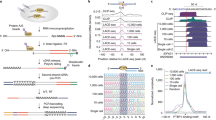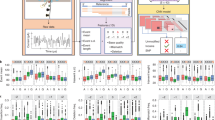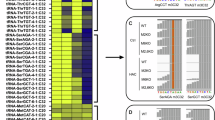Abstract
The translational recoding of UGA as selenocysteine (Sec) is directed by a SECIS element in the 3′ untranslated region (UTR) of eukaryotic selenoprotein mRNAs. The selenocysteine insertion sequence (SECIS) contains two essential tandem sheared G·A pairs that bind SECIS-binding protein 2 (SBP2), which recruits a selenocysteine-specific elongation factor and Sec-tRNASec to the ribosome. Here we show that ribosomal protein L30 is a component of the eukaryotic selenocysteine recoding machinery. L30 binds SECIS elements in vitro and in vivo, stimulates UGA recoding in transfected cells and competes with SBP2 for SECIS binding. Magnesium, known to induce a kink-turn in RNAs that contain two tandem G·A pairs, decreases the SBP2–SECIS complex in favor of the L30-SECIS interaction. We propose a model in which SBP2 and L30 carry out different functions in the UGA recoding mechanism, with the SECIS acting as a molecular switch upon protein binding.
This is a preview of subscription content, access via your institution
Access options
Subscribe to this journal
Receive 12 print issues and online access
$259.00 per year
only $21.58 per issue
Buy this article
- Purchase on SpringerLink
- Instant access to full article PDF
Prices may be subject to local taxes which are calculated during checkout







Similar content being viewed by others
Accession codes
References
Driscoll, D.M. & Copeland, P.R. Mechanism and regulation of selenoprotein synthesis. Annu. Rev. Nutr. 23, 17–40 (2003).
Hatfield, D.L. & Gladyshev, V.N. How selenium has altered our understanding of the genetic code. Mol. Cell. Biol. 22, 3565–3576 (2002).
Huttenhofer, A., Westhof, E. & Bock, A. Solution structure of mRNA hairpins promoting selenocysteine incorporation in Escherichia coli and their base-specific interaction with special elongation factor SELB. RNA 2, 354–366 (1996).
Zinoni, F., Heider, J. & Bock, A. Features of the formate dehydrogenase mRNA necessary for decoding of the UGA codon as selenocysteine. Proc. Natl. Acad. Sci. USA 87, 4660–4664 (1990).
Kromayer, M., Wilting, R., Tormay, P. & Bock, A. Domain structure of the prokaryotic selenocysteine-specific elongation factor SelB. J. Mol. Biol. 262, 413–420 (1996).
Suppmann, S., Persson, B.C. & Bock, A. Dynamics and efficiency in vivo of UGA-directed selenocysteine insertion at the ribosome. EMBO J. 18, 2284–2293 (1999).
Huttenhofer, A. & Bock, A. Selenocysteine inserting RNA elements modulate GTP hydrolysis of elongation factor SelB. Biochemistry 37, 885–890 (1998).
Berry, M.J. et al. Recognition of UGA as a selenocysteine codon in type I deiodinase requires sequences in the 3′ untranslated region. Nature 353, 273–276 (1991).
Martin, G.W. & Berry, M.J. SECIS elements. in Selenium: Its Molecular Biology and Role in Human Health (ed. Hatfield, D.L.) 45–54 (Kluwer Academic, Amsterdam, 2001).
Fagegaltier, D. et al. Characterization of mSelB, a novel mammalian elongation factor for selenoprotein translation. EMBO J. 19, 4796–4805 (2000).
Tujebajeva, R.M. et al. Decoding apparatus for eukaryotic selenocysteine insertion. EMBO Rep. 1, 158–163 (2000).
Copeland, P.R., Fletcher, J.E., Carlson, B.A., Hatfield, D.L. & Driscoll, D.M. A novel RNA binding protein, SBP2, is required for the translation of mammalian selenoprotein mRNAs. EMBO J. 19, 306–314 (2000).
Zavacki, A.M. et al. Coupled tRNA(Sec)-dependent assembly of the selenocysteine decoding apparatus. Mol. Cell 11, 773–781 (2003).
Fletcher, J.E., Copeland, P.R. & Driscoll, D.M. Polysome distribution of phospholipid hydroperoxide glutathione peroxidase mRNA: evidence for a block in elongation at the UGA/selenocysteine codon. RNA 6, 1573–1584 (2000).
Martin, G.W. & Berry, M.J. Selenocysteine codons decrease polysome association on endogenous selenoprotein mRNAs. Genes Cells 6, 121–129 (2001).
Fagegaltier, D., Lescure, A., Walczak, R., Carbon, P. & Krol, A. Structural analysis of new local features in SECIS RNA hairpins. Nucleic Acids Res. 28, 2679–2689 (2000).
Grundner-Culemann, E., Martin, G.W., Harney, J.W. & Berry, M.J. Two distinct SECIS structures capable of directing selenocysteine incorporation in eukaryotes. RNA 5, 625–635 (1999).
Fletcher, J.E., Copeland, P.R., Driscoll, D.M. & Krol, A. The selenocysteine incorporation machinery: interactions between the SECIS RNA and the SECIS-binding protein SBP2. RNA 7, 1442–1453 (2001).
Copeland, P.R. & Driscoll, D.M. Purification, redox sensitivity, and RNA binding properties of SECIS-binding protein 2, a protein involved in selenoprotein biosynthesis. J. Biol. Chem. 274, 25447–25454 (1999).
Lesoon, A., Mehta, A., Singh, R., Chisolm, G.M. & Driscoll, D.M. An RNA-binding protein recognizes a mammalian selenocysteine insertion sequence element required for cotranslational incorporation of selenocysteine. Mol. Cell. Biol. 17, 1977–1985 (1997).
Moore, T., Zhang, Y., Fenley, M.O. & Li, H. Molecular basis of box C/D RNA-protein interactions; cocrystal structure of archaeal L7Ae and a box C/D RNA. Structure (Camb.) 12, 807–818 (2004).
Hamma, T. & Ferre-D'Amare, A.R. Structure of protein L7Ae bound to a K-turn derived from an archaeal box H/ACA sRNA at 1.8 Å resolution. Structure (Camb.) 12, 893–903 (2004).
Vidovic, I., Nottrott, S., Hartmuth, K., Luhrmann, R. & Ficner, R. Crystal structure of the spliceosomal 15.5 kD protein bound to a U4 snRNA fragment. Mol. Cell 6, 1331–1342 (2000).
Mao, H., White, S.A. & Williamson, J.R. A novel loop-loop recognition motif in the yeast ribosomal protein L30 autoregulatory RNA complex. Nat. Struct. Biol. 6, 1139–1147 (1999).
Frankel, A.D. If the loop fits. Nat. Struct. Biol. 6, 1081–1083 (1999).
Mehta, A., Rebsch, C.M., Kinzy, S.A., Fletcher, J.E. & Copeland, P.R. Efficiency of mammalian selenocysteine incorporation. J. Biol. Chem. 279, 37852–37859 (2004).
Charron, C. et al. The archaeal sRNA binding protein L7Ae has a 3D structure very similar to that of its eukaryal counterpart while having a broader RNA-binding specificity. J. Mol. Biol. 342, 757–773 (2004).
Low, S.C., Grundner-Culemann, E., Harney, J.W. & Berry, M.J. SECIS-SBP2 interactions dictate selenocysteine incorporation efficiency and selenoprotein hierarchy. EMBO J. 19, 6882–6890 (2000).
Copeland, P.R., Stepanik, V.A. & Driscoll, D.M. Insight into mammalian selenocysteine insertion: domain structure and ribosome binding properties of Sec insertion sequence binding protein 2. Mol. Cell. Biol. 21, 1491–1498 (2001).
Goody, T.A., Melcher, S.E., Norman, D.G. & Lilley, D.M. The kink-turn motif in RNA is dimorphic, and metal ion-dependent. RNA 10, 254–264 (2004).
Matsumura, S., Ikawa, Y. & Inoue, T. Biochemical characterization of the kink-turn RNA motif. Nucleic Acids Res. 31, 5544–5551 (2003).
Walczak, R., Westhof, E., Carbon, P. & Krol, A. A novel RNA structural motif in the selenocysteine insertion element of eukaryotic selenoprotein mRNAs. RNA 2, 367–379 (1996).
Dabeva, M.D. & Warner, J.R. The yeast ribosomal protein L32 and its gene. J. Biol. Chem. 262, 16055–16059 (1987).
Vilardell, J., Yu, S.J. & Warner, J.R. Multiple functions of an evolutionarily conserved RNA binding domain. Mol. Cell 5, 761–766 (2000).
Spahn, C.M. et al. Structure of the 80S ribosome from Saccharomyces cerevisiae: tRNA-ribosome and subunit-subunit interactions. Cell 107, 373–386 (2001).
Vilardell, J. & Warner, J.R. Ribosomal protein L32 of Saccharomyces cerevisiae influences both the splicing of its own transcript and the processing of rRNA. Mol. Cell. Biol. 17, 1959–1965 (1997).
Li, B., Vilardell, J. & Warner, J.R. An RNA structure involved in feedback regulation of splicing and of translation is critical for biological fitness. Proc. Natl. Acad. Sci. USA 93, 1596–1600 (1996).
Dabeva, M.D. & Warner, J.R. Ribosomal protein L32 of Saccharomyces cerevisiae regulates both splicing and translation of its own transcript. J. Biol. Chem. 268, 19669–19674 (1993).
Chao, J.A., Prasad, G.S., White, S.A., Stout, C.D. & Williamson, J.R. Inherent protein structural flexibility at the RNA-binding interface of L30e. J. Mol. Biol. 326, 999–1004 (2003).
Kinter, M.T. & Sherman, N.E. Protein Sequencing and Identification Using Tandem Mass Spectrometry (Wiley-Interscience, New York, 2000).
Tran, E.J., Zhang, X. & Maxwell, E.S. Efficient RNA 2'-O-methylation requires juxtaposed and symmetrically assembled archaeal box C/D and C'/D' RNPs. EMBO J. 22, 3930–3940 (2003).
Acknowledgements
We thank B. Willard and M. Kinter of the Mass Spectrometry Facilities of the Cleveland Clinic Foundation for performing the mass spectrometry experiments. The liquid chromatography–mass spectrometry instrument used in this study was purchased with funding from the US National Institutes of Health (RR16794) and the State of Ohio Hayes Investment Trust Fund. We also thank C. Gerber for the preparation of rat tissue extracts, P. Copeland for providing the luciferase reporter constructs, W. Merrick for providing ribosomes from rabbit reticulocyte lysate, J. Suryadi (Wake Forest University) for expressing and purifying the M. jannaschii L7Ae protein, and C. Gerber and L. Middleton for reading the manuscript. This work was supported by Public Health Service grant HL29582 (D.M.D.), American Cancer Society grant IRG 95-035-09 (B.A.B.), and the Wake Forest University Science Research Fund (B.A.B.).
Author information
Authors and Affiliations
Corresponding author
Ethics declarations
Competing interests
The authors declare no competing financial interests.
Supplementary information
Supplementary Fig. 1
Size fractionation on a Sephacryl S400 column. (PDF 1724 kb)
Supplementary Fig. 2
Determination of apparent Kd values of L30, SBP2 and L7Ae for the SECIS. (PDF 212 kb)
Supplementary Fig. 3
Characterization of SECIS–protein complexes by supershift analyses. (PDF 217 kb)
Supplementary Methods
Cloning and expression of recombinant proteins. (PDF 21 kb)
Rights and permissions
About this article
Cite this article
Chavatte, L., Brown, B. & Driscoll, D. Ribosomal protein L30 is a component of the UGA-selenocysteine recoding machinery in eukaryotes. Nat Struct Mol Biol 12, 408–416 (2005). https://doi.org/10.1038/nsmb922
Received:
Accepted:
Published:
Issue date:
DOI: https://doi.org/10.1038/nsmb922
This article is cited by
-
Influence of Dietary Selenium on the Oxidative Stress in Horses
Biological Trace Element Research (2023)
-
SECISBP2 is a novel prognostic predictor that regulates selenoproteins in diffuse large B-cell lymphoma
Laboratory Investigation (2021)
-
New Directions for Understanding the Codon Redefinition Required for Selenocysteine Incorporation
Biological Trace Element Research (2019)
-
The unique tRNASec and its role in selenocysteine biosynthesis
Amino Acids (2018)
-
Evolution of the archaeal and mammalian information processing systems: towards an archaeal model for human disease
Cellular and Molecular Life Sciences (2017)



